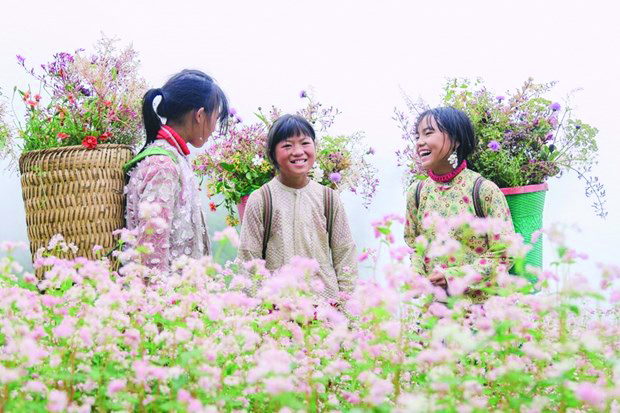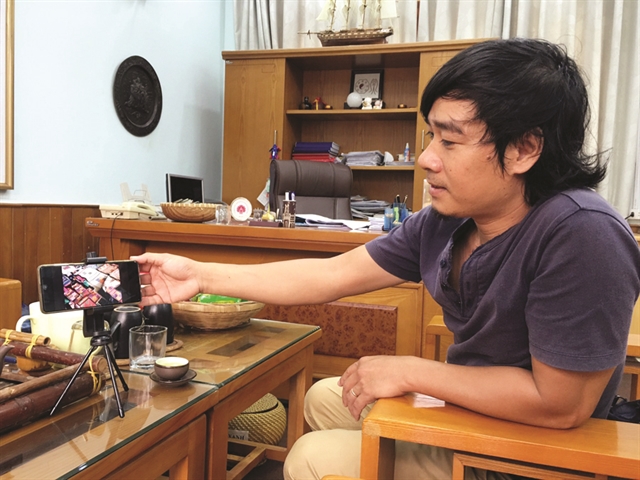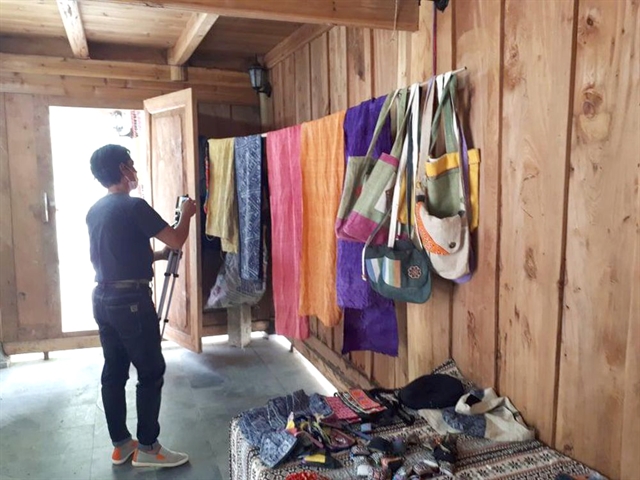
Children in Hà Giang stand in a buckwheat flower field. — VNA/VNS Photo
Lương Thu Hương
The COVID-19 pandemic has forced many travel enthusiasts to cancel their plans, but a number of Japanese tourists can still visit the northern province of Hà Giang by joining a series of virtual tours.
One of the regular participants of the tours since they were launched in July is Tsuno Mari from Yokohama.
“I have never been to Hà Giang due to the distance and the COVID-19 pandemic," she said.
"The terrain is too dangerous. I almost have no chance of visiting this place. That’s why I’ve joined this online tour.”
The virtual tours that feature the stunning landscapes and original cultural identities of the ethnic communities in Hà Giang Province were initiated by Hồ Trọng Tiến, a tour guide from HCM City, who has chosen to stay in the province since the fourth wave of the pandemic hit Việt Nam.

Tiến surveys the scene to prepare for his virtual tours. — VNA/VNS Photo Xuân Minh
Like other tour guides, Tiến’s job has been disrupted by the pandemic. He used to guide Japanese tourists but none have arrived since flights were halted. However, thanks to his close collaboration with a Japanese business partner, the 41-year-old has discovered that the Japanese have high demand for online travel, which also inspired him to make the first virtual tours dedicated to the market.
“It took me two months to test the device and prepare for the content," he added.
"After trials on a number of social networking platforms, my Japanese business partner and I agreed to operate the tours via Zoom.
“The first ones I did was a tour to a pomelo orchard in Biên Hòa District in the southern province of Đồng Nai in July last year. It was so highly appreciated by the Japanese tourists that I decided to deploy the model in many other localities.”
He revealed that the travel agency in Japan takes the responsibility of setting up the tours and arranging participants while he is in charge of creating new content to introduce to visitors. Many tourists have expressed their interest in learning about the cultural identity of Vietnamese ethnic groups.
Tiến said: “Around May, when I was conducting a programme about Hà Nội and Hạ Long, I was informed about the complicated situation of the pandemic in HCM City, so I decided not to return home. Instead, I travelled to the northwestern region and created online tours in a number of localities, especially Hà Giang.
“It took me only one week to prepare for the first virtual tour in the province thanks to my previous experience.”

Each virtual tour has from 10 to 15 guests. — Photo baohagiang.vn
Since July, Tiến has run about ten tours to popular destinations in Hà Giang Province like Đồng Văn Ancient Town, the villages of the Lô Lô in Mèo Vạc District and most recently, the tam giác mạch (buckwheat) flower fields.
Each programme only serves from ten and to a maximum of 15 tourists to ensure the quality of the internet connection and interaction between the Vietnamese tour guide and Japanese customers. Each online tour will then be uploaded to Youtube for free broadcast in Japan.
“Normally a month I do one long intensive tour of about 90 minutes and one short tour of about 45 minutes. The tour price ranges from 3,000-6,000 Japanese yen that is equivalent to VNĐ600,000-1.2 million (US$26-52) per person,” he added.
Since the success of those tours, Tiến has been invited to coordinate with Hà Giang Provincial Department of Tourism to create online programmes that aim to promote the images and traditional values of the province to Japanese tourists and some other countries.
He said: “I have conducted two programmes with the support of the department – one on the terraced fields in mid-October 2021 and another on the buckwheat flower season and the festival of the Lô Lô ethic minority in Lũng Cú at the end of November 2021.
"Another two will be launched from the middle to the end of this month, featuring traditional dishes and brocade weaving of the Mông; local gardens with special agricultural products and medicinal herbs.”
Conducting online tours is actually different and more difficult than in-person ones.
He added: "A reality tour can take all day during which guests could take a break, however, the virtual ones are limited to just over one hour. The break time is short, from a few seconds to two or three minutes, so sometimes I have to move among locations as fast as I can to prevent wasting time.”
Scripts and content of the virtual tours must be carefully prepared and sent to customers beforehand and can only be held in locations with stable internet connection to ensure image quality.
“Sometimes when I lead tourists into the mountains or caves then I lose internet connection. Therefore, videos must always be prepared in advance to fill the gaps,” he said.
According to Tiến, what has charmed Japanese tourists to Hà Giang Province is the stunning pristine beauty of the landscapes, the terraced fields, the kermis, the cultural identities of the local ethnic groups and particularly, the embroidered patterns on their costumes.
“Understanding their interest, I have spent more time filming in close up and describing the traditional clothes of the local ethnic people, which has made the Japanese tourists excited.

According to Tiến, Japanese tourists are particularly interested in the embroidered patterns on the traditional costumes of the ethnic minorities. — VNA/VNS Photo Xuân Minh
For many Japanese customers, Tiến’s programme is like a favourite pastime during the pandemic.
“His tours are amazing, that’s why I sign up for them. Even though it’s online, it’s very realistic and it relaxes me,” said Mari.
“Hà Giang is beautiful. Local ethnic people’s clothes are also beautiful. I find everything in the province interesting so I want to be there someday.”
According to Phùng Quang Thắng, Chairman of the Hanoi Travel Association, Hà Giang is one of the leading localities in applying digital platforms in the field of tourism, demonstrating flexibility and adaptability of the province in the new context of the COVID-19 pandemic.
“Online tours not only offered Hà Giang a new method to promote its tourism and at the same time helped travel firms build new activities. They should be promoted and deployed in other tourist attractions across the country," he emphasised. — VNS
(Source: vietnamnews.vn)